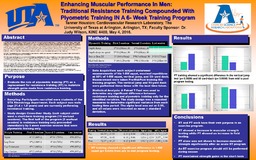| dc.contributor.author | Houston, Tanner | |
| dc.date.accessioned | 2017-07-06T21:58:54Z | |
| dc.date.available | 2017-07-06T21:58:54Z | |
| dc.date.issued | 2016 | |
| dc.identifier.uri | http://hdl.handle.net/10106/26864 | |
| dc.description | KINE 4400 | en_US |
| dc.description.abstract | INTRODUCTION: In-season training for athletes is a tricky time when it comes to maintaining performance on the field. They spend all off-season training their bodies to perform at peak performance when the game is on the line, but during the season training can be a totally different story. The combination of games, practices, and workouts during a season can lead to an early onset of fatigue that can decrease performance prematurely either late in games or throughout an entire prolonged season, so training regimens are bolstered to decrease the intensity during the season to where players can last the entire season with significant injury. It is well documented that performing resistance training (RT) months in advanced has positive effects on muscular strength and hypertrophy. It is also documented that plyometric training (PT) months prior leading up to performance has positive effects on muscular performance such as vertical jump (VJ) or sprinting. These resulting in a neural adjustment of the muscle fibers such as enhanced motor recruitment or an increase in the firing frequency. A combination of RT and PT have been shown to have the greatest increase in muscular performance than other trainings individually.
PURPOSE: The purpose of this study was to evaluate the role of plyometric training as a replacement for resistance training during in-season play in order to maintain muscular strength gains made in the off-season.
METHODS: Seven men (M; age 21.4 +1.9 yrs) of the UTA Kinesiology department, with a history of resistance training volunteered to participate in this study. Each subject had demographic data recorded. Each subject performed a short-term, compound training program of an initial 2 weeks of resistance training (RT) only followed by 2 weeks plyometric training (PT) only. Pre, during and post test were conducted gathering data on each subject’s vertical jump (VJ) height, 1-repetition maximum squat (1-RM), 60% of 1-RM of squats repetitions, and 50-yard sprint time.
RESULTS: In comparing RT with PT, a significant difference was found in the subjects’ 1-RM from pre-testing to mid-testing (p= 0.025). The number of reps at 60% of 1-RM, vertical jump, and 50-yard dash saw no significant difference in the time period between pre to mid program testing. There was a significant difference in the vertical jump (p=0.0009) and 50-yard dash (p=0.0059) in the mid program to post program testing. There was no significant difference between the subjects 1-RM squat and repetitions at 60% of the subject 1-RM during the plyometric portion of the training program.
CONCLUSION: The results of this study indicate that resistance training and plyometric training each have their own purpose in an exercise program. Resistance training as shown is needed to increase muscular strength and cannot be replaced by plyometric training alone, so even during a highly competitive season there needs to be some sort of resistance training program to maintain muscular strength gained during the offseason. | en_US |
| dc.description.sponsorship | Wilson, Judy | en_US |
| dc.language.iso | en_US | en_US |
| dc.subject | Athletes -- men | en_US |
| dc.subject | Resistance training | en_US |
| dc.subject | Plyometric training | en_US |
| dc.subject | Muscular strength | en_US |
| dc.title | Enhancing Muscular Performance In Men: Traditional Resistance Training Compounded With Plyometric Training IN A 6-Week Training Program | en_US |
| dc.type | Presentation | en_US |
| dc.publisher.department | Department of Kinesiology, The University of Texas at Arlington | en_US |
| dc.publisher.department | Cardiovascular Research Laboratory, The University of Texas at Arlington | en_US |
| dc.publisher.department | Exercise Science Research Laboratories, The University of Texas at Arlington | en_US |

